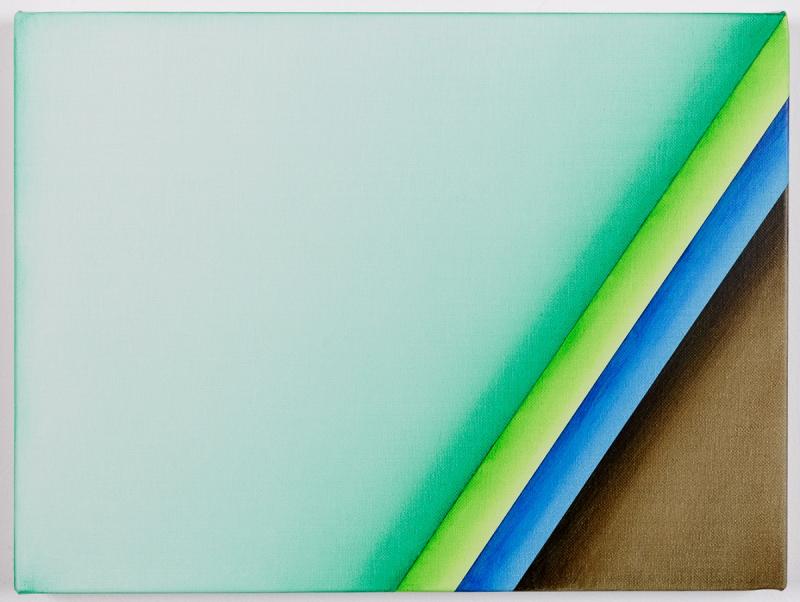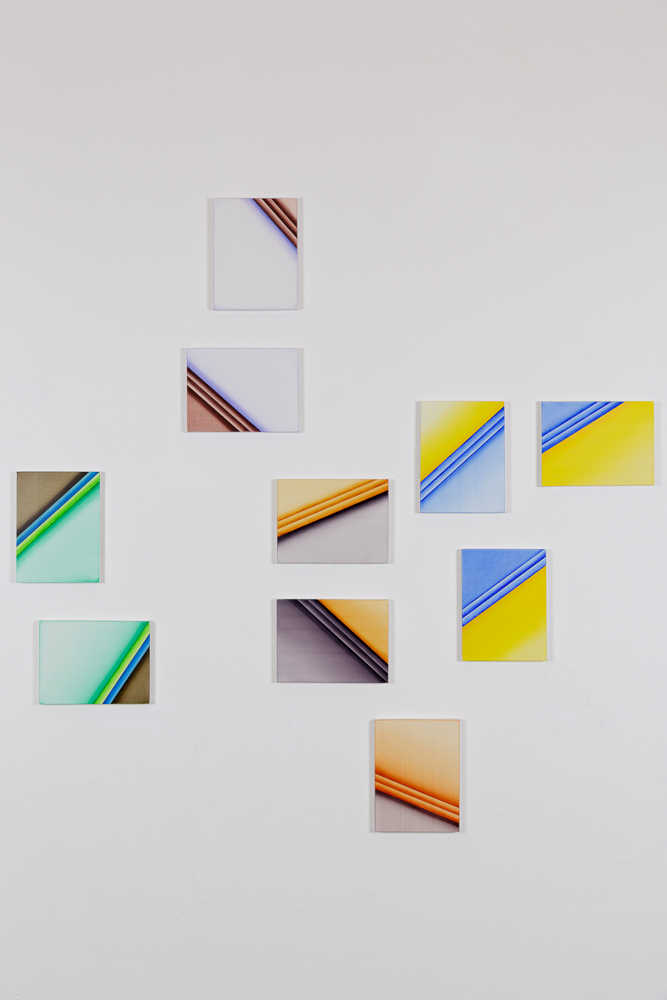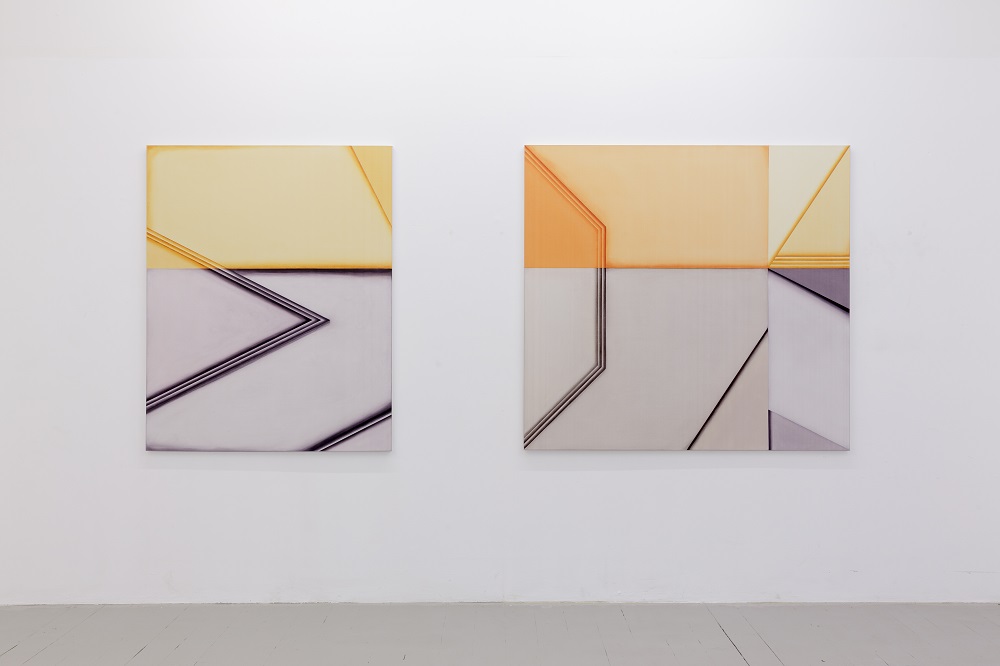Selma Parlour: Upright Animal, Pi Artworks review - incandescent colours | reviews, news & interviews
Selma Parlour: Upright Animal, Pi Artworks review - incandescent colours
Selma Parlour: Upright Animal, Pi Artworks review - incandescent colours
Opaque paintings evoke Renaissance perspective, classical architecture and satellite landscapes

In the dark days of January, white cube galleries are luminous spaces. This is especially true of Pi Artworks right now: the Fitzrovia gallery is showing an incandescent array of 23 paintings by Selma Parlour. Taken in at once and at first sight, her abstract works arrest the eye with unlikely chords of colour and angular planes that suggest competing vanishing points.
The London-based painter has laid claim to a palette of lively yet soft colours in which gray-mauve and burnt ochre both stand out, Further striking moments are provided by electric blues, a deep turquoise and a treacle-like golden yellow. Just a stone’s throw away on Oxford Street, the shop-window dressers offer less incongruous pleasures. You might conclude that Parlour’s colours are neither fashionable nor seasonal. As a serious painter, it must take effort to avoid being either.
 And so Upright Animal, as the show is called, occupies a pocket outside of time and the outside of populism. Parlour uses delicate, hardly photogenic films of oil on linen. Her planes of colour are either devoid of texture or, at best, smoky around the edges. Colours come up against one another in moments of drama, and their difference is underscored by clinical borders, often made with tape, often so dark they look like an incision has been made in the linen ground.
And so Upright Animal, as the show is called, occupies a pocket outside of time and the outside of populism. Parlour uses delicate, hardly photogenic films of oil on linen. Her planes of colour are either devoid of texture or, at best, smoky around the edges. Colours come up against one another in moments of drama, and their difference is underscored by clinical borders, often made with tape, often so dark they look like an incision has been made in the linen ground.
What are these shapes? They enter the field of vision like a featureless columnade by de Chirico, or the receding walls of a garden in an otherwise blank early Renaissance landscape, designed to show off the artist’s grasp of perspective. But any sense of architectural coherence is complicated by the differing agendas of her various visual forms. The whole show is characterised by painterly humour: visual jokes, in other words, that painters may find more amusing than non-painters.
With their lack of detail and their frustrating sense of depth, it is still hard not to read these planar works as landscapes. They also bring to mind aerial photography, a god’s eye viewpoint that is now universal, thanks to Google and drone footage. These could be deserts seen from the air, compounds in which the inhabitants have gone to ground, remote hideouts haunted by death from above. The works in the show’s eponymous series (Upright Animal I and Upright Animal II) certainly imply as much. They are black and white, featureless, and somewhat ominous.
However, many other moods are generated. Invented Vocabulary compiles five works of modest size which lure the eye into a tessellated puzzle of rich colours that recall more innocent forms of travel: a vacation with beach yellow and sky blue. But with a predominance of greys and ochres, all of this really amounts to a series of chess moves in which Parlour makes works that advance the ambit of abstract painting, and which move slowly into previously unoccupied territories of colour and form. But taken together, all these works do indeed form a landscape: an inner landscape which Parlour lets you glimpse but never fully apprehend. Ten smaller works, a series called Detail Shot, are clustered together. Nowhere do her paintings suggest windows so clearly. Nowhere do they frustrate the intuition so blatantly. The forms fail to interlock and the colours don’t match. This proliferation of vistas defies the viewer to apprehend any kind of overarching logic.
But taken together, all these works do indeed form a landscape: an inner landscape which Parlour lets you glimpse but never fully apprehend. Ten smaller works, a series called Detail Shot, are clustered together. Nowhere do her paintings suggest windows so clearly. Nowhere do they frustrate the intuition so blatantly. The forms fail to interlock and the colours don’t match. This proliferation of vistas defies the viewer to apprehend any kind of overarching logic.
Detail Shot is also notable for its use of colour. It offers some of the most pleasing juxtapositions in the show: mint with brown, mauve with tan, gold with blue, lilac with aubergine. But given Parlour’s interest in limits, the colours appear secondary to the form. They are mere entities for delimitation. This show is all about the angular borders which slice up these delectable colours. In places these ridge like lines suggest architraves: a classical quotation that resists abstraction and connects this show, once again, to the history of art.
Parlour is a cerebral painter, with a PhD from Goldsmiths. Her thesis was called Depicting Limits: Syntax, Abstraction and Space in Contemporary Painting. Her limits, borders and edges are the very focus of the works. But Parlour implies a proliferation of barriers off-camera too. None of her paintings are framed and the space which they generate, extends around the entire gallery, keeping this small, gemlike show in taut focus, giving us limits we must everywhere traverse.
rating
Explore topics
Share this article
The future of Arts Journalism
You can stop theartsdesk.com closing!
We urgently need financing to survive. Our fundraising drive has thus far raised £49,000 but we need to reach £100,000 or we will be forced to close. Please contribute here: https://gofund.me/c3f6033d
And if you can forward this information to anyone who might assist, we’d be grateful.

Subscribe to theartsdesk.com
Thank you for continuing to read our work on theartsdesk.com. For unlimited access to every article in its entirety, including our archive of more than 15,000 pieces, we're asking for £5 per month or £40 per year. We feel it's a very good deal, and hope you do too.
To take a subscription now simply click here.
And if you're looking for that extra gift for a friend or family member, why not treat them to a theartsdesk.com gift subscription?
more Visual arts
 'We are bowled over!' Thank you for your messages of love and support
Much-appreciated words of commendation from readers and the cultural community
'We are bowled over!' Thank you for your messages of love and support
Much-appreciated words of commendation from readers and the cultural community
 Lee Miller, Tate Britain review - an extraordinary career that remains an enigma
Fashion photographer, artist or war reporter; will the real Lee Miller please step forward?
Lee Miller, Tate Britain review - an extraordinary career that remains an enigma
Fashion photographer, artist or war reporter; will the real Lee Miller please step forward?
 Kerry James Marshall: The Histories, Royal Academy review - a triumphant celebration of blackness
Room after room of glorious paintings
Kerry James Marshall: The Histories, Royal Academy review - a triumphant celebration of blackness
Room after room of glorious paintings
 Folkestone Triennial 2025 - landscape, seascape, art lovers' escape
Locally rooted festival brings home many but not all global concerns
Folkestone Triennial 2025 - landscape, seascape, art lovers' escape
Locally rooted festival brings home many but not all global concerns
 Sir Brian Clarke (1953-2025) - a personal tribute
Remembering an artist with a gift for the transcendent
Sir Brian Clarke (1953-2025) - a personal tribute
Remembering an artist with a gift for the transcendent
 Emily Kam Kngwarray, Tate Modern review - glimpses of another world
Pictures that are an affirmation of belonging
Emily Kam Kngwarray, Tate Modern review - glimpses of another world
Pictures that are an affirmation of belonging
 Kiefer / Van Gogh, Royal Academy review - a pairing of opposites
Small scale intensity meets large scale melodrama
Kiefer / Van Gogh, Royal Academy review - a pairing of opposites
Small scale intensity meets large scale melodrama
 Jenny Saville: The Anatomy of Painting, National Portrait Gallery review - a protégé losing her way
A brilliant painter in search of a worthwhile subject
Jenny Saville: The Anatomy of Painting, National Portrait Gallery review - a protégé losing her way
A brilliant painter in search of a worthwhile subject
 Abstract Erotic, Courtauld Gallery review - sculpture that is sensuous, funny and subversive
Testing the boundaries of good taste, and winning
Abstract Erotic, Courtauld Gallery review - sculpture that is sensuous, funny and subversive
Testing the boundaries of good taste, and winning
 Edward Burra, Tate Britain review - watercolour made mainstream
Social satire with a nasty bite
Edward Burra, Tate Britain review - watercolour made mainstream
Social satire with a nasty bite
 Ithell Colquhoun, Tate Britain review - revelations of a weird and wonderful world
Emanations from the unconscious
Ithell Colquhoun, Tate Britain review - revelations of a weird and wonderful world
Emanations from the unconscious
 Rachel Jones: Gated Canyons, Dulwich Picture Gallery review - teeth with a real bite
Mouths have never looked so good
Rachel Jones: Gated Canyons, Dulwich Picture Gallery review - teeth with a real bite
Mouths have never looked so good

Add comment